Arata Isozaki
Arata Isozaki | |
|---|---|
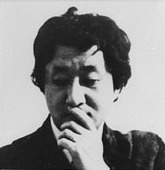 Arata Isozaki in 1976 | |
| Born | 23 July 1931[1] Oita, Japan |
| Nationality | Japan |
| Alma mater | University of Tokyo (1954) |
| Occupation | Architect |
| Awards |
|
| Buildings |
|
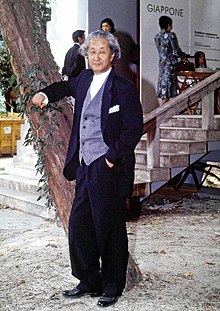

Arata Isozaki (磯崎 新, Isozaki Arata; born 23 July 1931) is a Japanese architect, urban designer, and theorist[3] from Ōita. He was awarded the RIBA Gold Medal in 1986 and the Pritzker Architecture Prize in 2019.
Biography[]
Isozaki was born in Oita on the island of Kyushu and grew up in the era of postwar Japan.[3]
Isozaki completed his schooling at the Oita Prefecture Oita Uenogaoka High School (erstwhile Oita Junior High School). In 1954, he graduated from the University of Tokyo where he majored in Architecture and Engineering. This was followed by a doctoral program in architecture from the same university.[1] Isozaki also worked under Kenzo Tange before establishing his own firm in 1963.[1]
Isozaki's early projects were influenced by European experiences with a style mixed between "New Brutalism" a "Metabolist Architecture" (Oita Medical Hall, 1959–1960), according to Reyner Banham. His style continued to evolve with buildings such as the Fujimi Country Club (1973–74) and Kitakyushu Central Library (1973–74). Later he developed a more modernistic style with buildings such as the Art Tower of Mito (1986–90) and Domus-Casa del Hombre (1991–1995) in Galicia, Spain. The Museum of Contemporary Art (MOCA) in Los Angeles, completed in 1986, was his first international project and his best known work in the U.S.[3] In 2005, Arata Isozaki founded the Italian branch of his office, Arata Isozaki & Andrea Maffei Associates. Two major projects from this office include: the Allianz Tower CityLife office tower, a redevelopment project in the former trade fair area in Milan, and the new Town Library in Maranello, Italy.[4]
Despite designing buildings both inside and outside Japan, Isozaki has been described as an architect who refuses to be stuck in one architectural style, highlighting "how each of his designs is a specific solution born out of the project’s context."[5] Isozaki won the Pritzker Architecture Prize in 2019.[2]
Awards[]
- Annual Prize, Architectural Institute of Japan in 1967 and 1975[6]
- Mainichi Art Award in 1983
- RIBA Gold Medal in 1986[6]
- International Award "Architecture in Stone" in 1987
- Arnold W. Brunner Memorial Prize of the American Academy and Institute of Arts and Letters in 1988
- Chicago Architecture Award in 1990
- Honor Award, the American Institute of Architects in 1992
- RIBA Honorary Fellow in 1994
- Golden Lion, 6^ Venice Biennale of Architecture in 1996
- The Award in 2012 for his Venice installation Zhongyuan.[7][8]
- Pritzker Prize in 2019[6]
Gallery[]
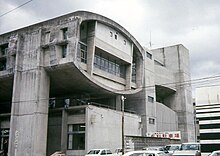
One of Isozaki's early projects, Oita Medical Hall (1959-1960), "mixed New Brutalism and Metabolist Architecture," according to one critic
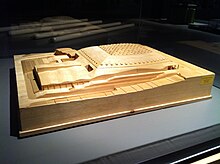
Model of Isozaki's Palau Sant Jordi
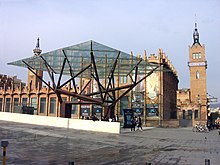
Entrance to CaixaForum Barcelona (2001)
Art Tower in Mito, Ibaraki (1990)
Notable works[]
- Ōita Prefectural Library, (1962–1966) Ōita, Ōita, Japan[6]
- Kitakyushu Municipal Museum of Art (1972–1974) in Fukuoka, Japan[6]
- Kitakyushu Central Library (1973–1974) in Fukuoka, Japan[6]
- Museum of Modern Art, Gunma (1974) in Takasaki, Japan[9]
- Museum of Contemporary Art (MOCA), (1981–1986) Los Angeles, California, United States[9]
- Sports Hall for the 1992 Summer Olympics, (1983–1990) Barcelona, Spain[6]
- Ochanomizu Square Building – Casals Hall, (1984–1987) Tokyo, Japan[6]
- Palladium nightclub building interior (1985) in New York City, United States[10]
- Lake Sagami Country Clubhouse (1987–1989), with stained glass skylights and lantern by Brian Clarke, Yamanishi, Japan[11]
- Art Tower Mito, Mito, (1986–1990) Ibaraki, Japan[6]
- Team Disney Orlando, (1987–1990) Florida, United States[6]
- Bond University, – Library, Administration Building, Faculty of Humanities Building (1987–1989) Gold Coast, Australia[6]
- KitaKyushu International Conference Center (1987–1990) Fukuoka, Japan[6]
- Palafolls Sports Complex Pavilion, (1987–1996) Barcelona, Spain[citation needed]
- Centre of Japanese Art and Technology, (1990–1994) Kraków, Poland[6]
- Nagi Museum Of Contemporary Art, (1991–1994) Okayama, Japan[6]
- Kyoto Concert Hall, (1991–1995) Kyoto, Japan[6]
- Nara Centennial Hall, (1992–1998) Nara, Japan[6]
- Domus: La Casa del Hombre, (1993–1995) A Coruña, Spain[6]
- Granship-Shizuoka Convention and Arts Center, (1993–1998) Shizuoka, Japan[6]
- COSI Columbus, (1994–1999) Columbus, Ohio, United States
- Shenzhen Cultural Center, (1998–2007) Shenzhen, China
- Includes Shenzhen Library and Shenzhen Concert Hall
- New entrance of the CaixaForum Barcelona building, (1999–2002) Barcelona, Spain
- Isozaki Atea, (1999–2009) Bilbao, Spain
- Torino Palasport Olimpico, (2000–2006) Turin, Italy
- Museum of the Central Academy of Fine Arts in Beijing, (2003–2008) China
- New Concert Hall Building, (2003–) Thessaloniki, Greece, 2010
- Himalayas Center, (2003–) Shanghai, China
- Pavilion of Japanese Army in World War II, Jianchuan Museum Cluster, (2004–2015) Chengdu, China
- Diamond Island, (2006–) Ho Chi Minh City, Vietnam (complete in 2012)
- Coliseum da Coruña, A Coruña, Galicia, Spain, 1991
- Weill Cornell Medical College in Qatar, Education City, near Doha
- Qatar National Convention Center, opened 2011[12]
- New Town Library (2012) in Maranello, Italy (Arata Isozaki and Andrea Maffei)
- D38 Office (2012) in Barcelona, Spain[13]
- Allianz Tower (Il Dritto) (2015), in Milan, Italy (Arata Isozaki and Andrea Maffei)[14]
- Harbin Concert Hall (2015), in Harbin, China
Current projects[]
- The University of Central Asia's three campuses in Tekeli, Kazakhstan; Naryn, the Kyrgyz Republic; and Khorog, Tajikistan
- The New exit for the Uffizi Gallery, Florence, Italy – competition winner (Arata Isozaki and Andrea Maffei)
- The renovation of the Bologna Centrale railway station, Bologna, Italy – competition winner
- Metropolis Thao Dien, Ho Chi Minh City, Vietnam
References[]
- ^ Jump up to: a b c Goodwin, Dario. "Spotlight: Arata Isozaki". ArchDaily. Retrieved 4 March 2019.
- ^ Jump up to: a b Allen, Katherine. "Arata Isozaki Named 2019 Pritzker Prize Laureate". ArchDaily. Retrieved 5 March 2019.
- ^ Jump up to: a b c Qin, Amy (9 March 2019). "The man who fused east and west: Arata Isozaki wins Pritzker Prize in architecture". Independent. Retrieved 26 June 2019.
- ^ Peressut, Luca Basso (1999). Musei: Architetture 1990–2000. ISBN 978-8871791999.
- ^ Leardi, Lindsey. "Arata Isozaki on "Ma," the Japanese Concept of In-Between Space". ArchDaily. Retrieved 4 March 2019.
- ^ Jump up to: a b c d e f g h i j k l m n o p q r "2019 Pritzker Architecture Prize Media Kit" (PDF). Pritzker Architecture Prize. The Hyatt Foundation. March 2019. Archived (PDF) from the original on 7 March 2019. Retrieved 6 March 2019.
- ^ "ECC AWARD". www.europeanculturalcentre.eu. Archived from the original on 17 July 2017. Retrieved 11 July 2017.
- ^ "Time-Space-Existence in Venice". www.world-architects.com. Archived from the original on 21 April 2018. Retrieved 11 July 2017.
- ^ Jump up to: a b "AD Classics: Museum of Modern Art, Gunma / Arata Isozaki". ArchDaily.
- ^ "Log 41". Anyone Corporation.
- ^ Arata Isozaki: Architecture 1960–1990. New York: The Museum of Contemporary Art, Los Angeles/Rizzoli International Publications. 1991. p. 291. ISBN 0-8478-1319-3.
- ^ Frearson, Amy. "Qatar National Convention Centre by Arata Isozaki". Dezeen. Retrieved 4 March 2019.
- ^ "D38 Office / Arata Isozaki". ArchDaily.
- ^ "ALLIANZ Tower / Arata Isozaki + Andrea Maffei". ArchDaily. Retrieved 4 March 2019.
External links[]
| Wikimedia Commons has media related to Arata Isozaki. |
- Arata Isozaki & associates
- Arata Isozaki at the Museum of Modern Art
- Corkill, Edan. "Arata Isozaki: Astonishing by design". Japan Times, 1 June 2008.
- Sarah F. Maclaren, "Arata Isozaki e la fine dell’utopia", in "Il senso della fine", Ágalma. Rivista di studi culturali e di estetica, 19, 2009: 61–75. ISSN 1723-0284.
- CityLife Official website of the project
- Liddell, Colin. "Arata Isozaki: Solaris". Metropolis, 23 January 2014.
- 1931 births
- Living people
- Japanese architects
- University of Tokyo alumni
- People from Ōita (city)
- Recipients of the Royal Gold Medal
- Commanders of the Order of Merit of the Republic of Poland
- Arata Isozaki buildings
- Honorary Members of the Royal Academy
- Pritzker Architecture Prize winners




